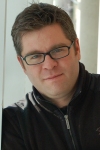A Geographer Rewrites the Rules of Innovation
David Doloreux examines the conditions for implementing regional innovation strategies.
 Innovation is partly a story of geography; it just might not be the one that researchers and policymakers have focused on to date.
Innovation is partly a story of geography; it just might not be the one that researchers and policymakers have focused on to date.
The latest studies from David Doloreux call into question the widely-held view that different locations enable different levels of access to information sources, R&D, collaborators, and markets that enable innovation.
“In our study of knowledge-intensive business services in the province of Quebec, we found that innovation varied both across continuous space and across discrete territories, and these variations could not be explained by differences in firms’ capacity to access information, knowledge and collaboration partners,” says Doloreux, Research Chair in Canadian Francophonie - Innovation, Entrepreneurship and Regional Development at the Telfer School of Management.
Intriguingly, in many cases firms were more innovative in remote areas than in cities, reflecting the fact that some firms seek out remote locations for strategic reasons, and the different nature of firms and markets in remote areas. Doloreux suggests that some innovation factors may vary continuously across space, such as reduction in the propensity of the firms to specialize in a particular niche, and higher internalization of innovation processes as one moves away from large urban areas.
Given the results, it would be worthwhile to examine whether the observed patterns of innovation “might be explained by unmeasured institutional, organizational or cultural factors – factors that are not merely local but also have wider spatial structures.”
It is not the first time Doloreux has lifted a geographer’s lens up to problem of innovation disparities, revealing unexpected findings. A prolific researcher, he has examined the assumptions linking entrepreneurship, creativity and innovation with the idea of region for more than a decade. Since coming to the University of Ottawa in 2007, he has also been busy developing the Telfer School’s capacity to carry out research in those areas, and participating in various research networks in northern European countries such as Sweden (postdoctoral work at the University of Lund), Germany (Visiting Professor at University of Kiel) and France (research collaboration involving the University of Toulouse).
The Agence Universitaire de la Francophonie recently recognized Doloreux’s contributions by awarding him the 2010-2011 prix de la Francophonie pour jeunes chercheurs in the field of Humanities and Social Sciences, a prestigious award given every two years to recognize a researcher “who has made a significant international contribution, particularly within the Francophonie.”
“Whether I am developing empirical findings or advancing theory, fundamentally my work is about developing a more systematic view of the different processes related to innovation, and linking that to the level of the region,” says Doloreux, whose training as a geographer includes a BA in Geography from UQAM, a Master’s in Geography at the Université de Montréal and a PhD in Urban Studies at the University of Waterloo.
Among his other recent contributions are key findings which throw open the question of what makes an effective regional innovation system. Using a major grant from the Social Sciences and Humanities Research Council, Doloreux and his co-investigators recently examined conditions for the development of industrial clusters and the ways in which they are integrated into the regional economy. The team concluded that the development of industry clusters constitutes “a long-term process, which depends on a careful development of arrangements between key actors that are anchored in the region.”
Doloreux and his colleagues demonstrated that clusters – defined as regional arrangements of businesses, government actors, public authorities and intermediary organizations – are based on actors and processes operating at different scales, from the local to the global.
The findings contribute to a more complex picture of the mechanisms thought to contribute best to innovation. As Doloreux and the Université du Québec’s Richard Shearmur conclude in an article in the Journal of Economic Geography: “Once one begins to seriously address the geography of innovation, one discovers how little one really knows and how much has simply been assumed.”

